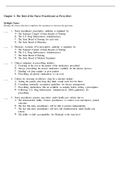Exam (elaborations)
CFA 3 - final formulas and lists (1) Exam Questions and Answers 2024( A+ GRADED 100%VERIFIED).
- Course
- Institution
CFA 3 - final formulas and lists (1) Exam Questions with complete solutions 2024( A+ GRADED 100%VERIFIED).
[Show more]












